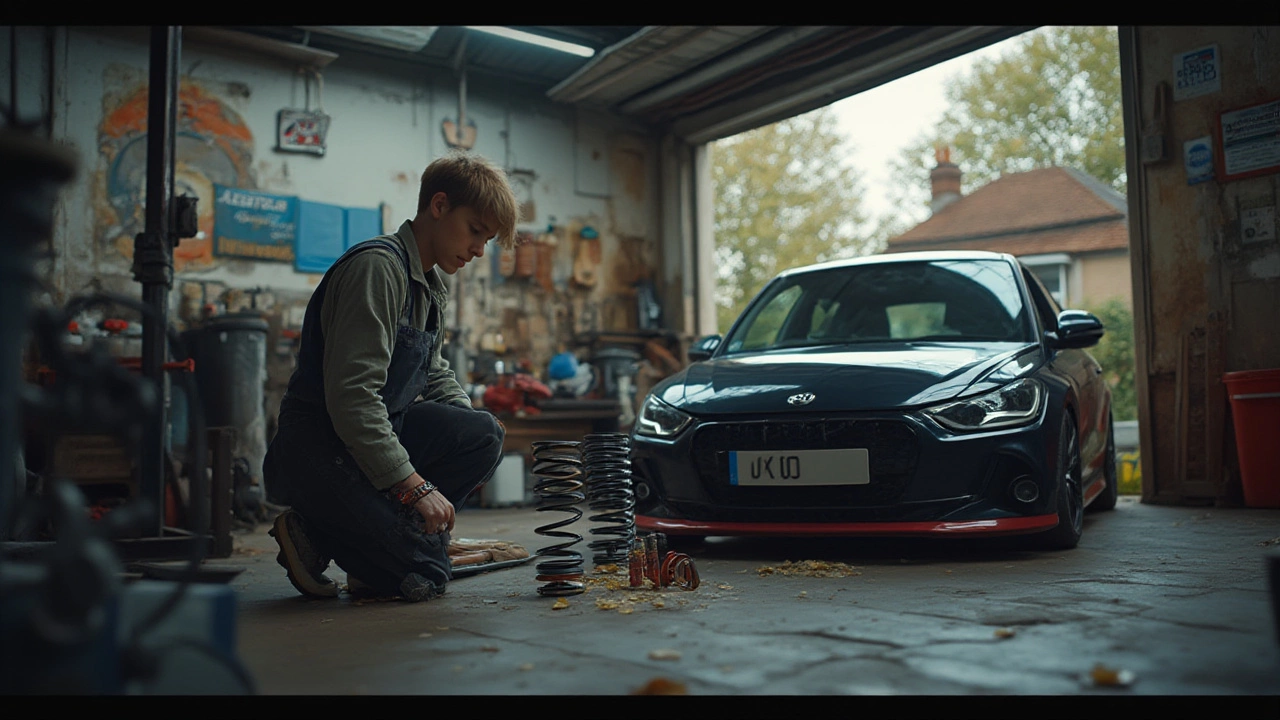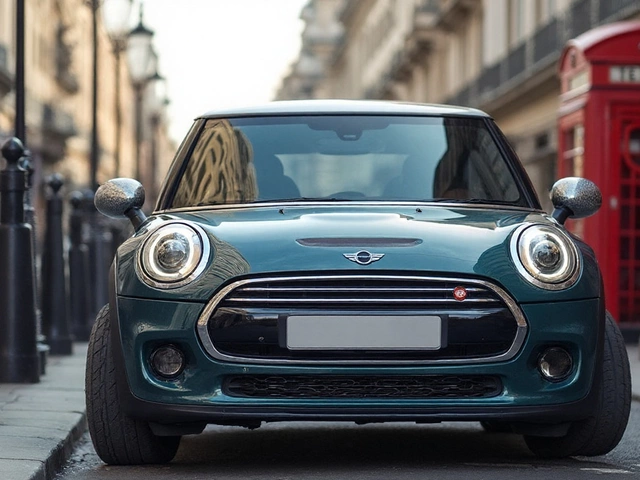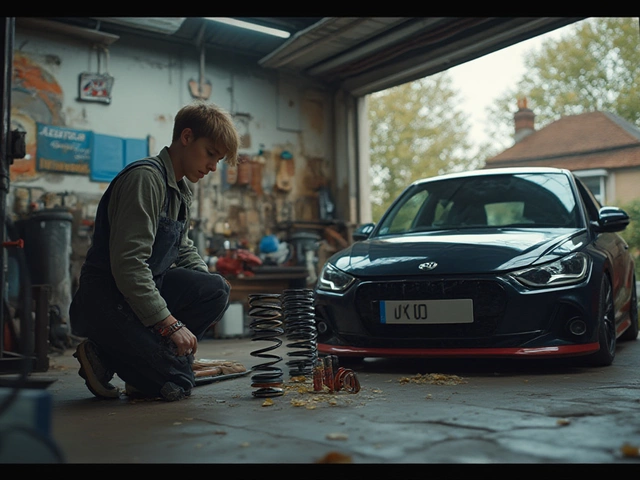If you’ve ever looked at your car and thought, “That wheel gap is killing me,” you aren’t alone. The idea of getting that aggressive, hunkered-down look without going all-in on a full suspension overhaul is tempting. Lowering springs dangle an almost magical promise: better looks, sharper handling, all without emptying your wallet. Can you just toss a set of lowering springs onto your stock suspension and call it a day? People do it all the time—but is it actually the smart move, or are you setting yourself up for a bumpy surprise?
What Happens When You Install Lowering Springs on Stock Suspension?
Slapping lowering springs onto your car’s factory shocks and struts isn’t some wild back-alley experiment. Car forums are packed with guys who’ve taken this shortcut. The main attraction is simple: lowering springs are way cheaper than coilovers or a full performance suspension kit. They drop the body closer to the wheels, which looks slick and can tighten up cornering. The theory is sound, but real life always has twists. When you install lowering springs, they’re usually stiffer and shorter than the factory springs. This means the shocks on your car—which were made for the original, taller, softer springs—now have to deal with more pressure and less travel room. They work harder, which can wear them out faster.
One study by Eibach, a well-known spring manufacturer, found that the average OE shock loses around 40% of its expected lifespan when paired with lowering springs in day-to-day driving. So if you usually get 100,000 miles from your shocks, that number could drop to 60,000, sometimes less if you live where roads are rough. You might not blow a shock right away, but you’ll probably start to notice more bounce or a “floaty” feeling a lot sooner than you would with a complete kit designed for lowering. No one enjoys a car that feels like it’s about to pogo stick down the highway.
Don’t forget about the actual drop itself. Lowering springs typically drop the car anywhere from 1 to 2.5 inches. This doesn’t seem massive until you hit a steep driveway or a rogue speed bump at the grocery store. You’ll scrape, and your heart rate will jump every time. Plus, since you’re riding on the edge of the shock’s travel, the bump stops get a workout. Some cars take it gracefully, but others feel harsh or jarring over even modest potholes.
There’s also the matter of alignment. Lowering a car changes suspension geometry. Suddenly, your wheels could end up with more negative camber, which looks cool but can chew up tires on daily drivers. Without an alignment right after lowering, uneven tire wear sneaks in. Factory alignment specs don’t always cover lowered cars either—you might need specialty shops or adjustable arms to get everything dialed in. That’s an extra cost to consider before you click “buy” on those springs.
All this isn’t to say throwing lowering springs on factory shocks is always a mistake. Plenty of folks do it and love the result, especially if they’re mostly after aesthetics. Just know up front: you’re trading some ride comfort and potentially long-term component health for a lower stance. Deciding if that’s worth it depends on what matters most to you—looks, cost, or daily comfort.
The Right Way To Lower On A Budget (And Rookie Mistakes to Dodge)
Maybe your budget shrieks every time you scroll past coilovers or full suspension kits. No shame there—lowering springs paired with stock suspension can be the move if you make smart decisions. Start by checking out what folks with your exact car model have done. Some cars, like the Honda Civic, tolerate lowering springs on original shocks pretty well for a while. Others, like some older BMWs or Mazdas, get too bouncy or clunky unless you swap out those shocks too.
It helps to think about spring rates and drop heights. Springs that lower the car by more than 1.5 inches put more stress on everything underneath. Manufacturers like H&R, Eibach, and Tein offer detailed specs—go for springs designed to work as close to factory comfort as possible. Chasing the slammed look on a stock suspension usually leads to headaches fast.
If you’re tempted to “cut” your original springs with a grinder—just don’t. Seriously, don't. Not only is it straight-up dangerous, but it can throw handling into chaos and cause the spring to jump out of its perch while driving. The low-priced lowering springs on eBay might look tempting, but reputable brands do actual R&D on their products so you’re less likely to explode your shocks in a few thousand miles.
You really need an alignment immediately after lowering. Here’s a quick snapshot of how camber and toe can change after a common 1.5" drop on a compact car:
| Spec | Factory | [email protected]" |
|---|---|---|
| Front Camber | -0.5° | -1.5° |
| Rear Camber | -1.0° | -2.0° |
| Front Toe | 0.05" in | 0.15" out |
| Rear Toe | 0.05" in | 0.12" out |
See what I mean? Tires could start to wear inside edges way sooner, and you’ll definitely sacrifice some stability if the toe spec goes wild, especially in wet weather. If you don’t have cash for adjustable parts, some shops can get things “good enough,” but it’s dicey territory.
One more trick—if your shocks already have more than 60,000 miles, factor bump stops and boots into your plan. Most stock shocks weren’t made to run with less travel, so those rubber bump stops get chewed up quickly. Brands like KYB and Monroe actually make OE replacement struts meant for slight lowering, and sometimes those are just a little pricier than basic replacements. Worth a look if you want to split the difference between cost and reliability.

The Real-World Ride: Comfort, Handling, and Daily Annoyances
The first thing you’ll notice after installing lowering springs is how much firmer everything feels. If you’ve ever pressed on your car’s fender after the swap and thought, “Dang, this is solid,” that’s normal. The car responds more immediately to steering input, taking corners with less roll. That part’s great until you hit bumpy or poorly paved roads. All that tighter handling can come with a stiffer, sometimes downright crashy ride. Especially if your streets look more like obstacle courses.
Another fun fact: your stock struts might “blow” (that’s car guy talk for losing oil or dampening ability) quicker with lowering springs installed. Expect more chatter and squeaks over time. You might also hear a thunk or clunk over bumps—that’s usually the springs binding up, or the shock bottoming out sooner than you’d like. It’s not the end of the world, but if you hate rattles, this will get old fast. Some cars develop a nose-up or saggy look in the rear because factory shocks and struts can’t always balance out the drop. Before you panic or think your install went wrong, take it back for a re-torque after a week. New springs can “settle” noticeably in the first few hundred miles.
Handling can absolutely improve, but there’s a tipping point. Drop your car too much or too fast and the geometry changes not only wear tires but can also chew up bushings and ball joints. Some guys run into serious problems—like axle boot tears—when they push things too low on untouched factory parts. On the upside, if your expected use is mostly smooth roads or light, spirited driving, most name-brand lowering springs won’t ruin your daily if you’re realistic about expectations.
But there are hidden perks worth considering. Aerodynamics improve a bit. Some wind tunnel test data from BMW showed that a moderate 1-inch drop can reduce lift at speed by up to 10%, improving highway stability and even eking out a bit of extra MPG at cruising speed. It’s not huge, but it’s a cool side bonus. Just don’t count on that to offset destroyed tires if you don’t get an alignment.
Rubbing can be an issue, too. Even with stock wheels and tires, extra passengers or a trunk full of groceries can bring the fenders dangerously close to making contact. This is why you see some lowered cars with rolled fenders or even slightly flared arches. In most cases, a mild drop (around 1-1.2 inches) is drama-free, but it starts to get sketchy fast beyond that—unless you plan to take extra steps with wheel alignment, tire selection, or even trimming some liner in the fender wells.
Another weird but true change: some lowered cars simply attract more attention. Cops may notice you more, while curious neighbors or fellow car lovers want to talk shop. If you live in a spot with yearly vehicle inspections, double-check local regulations. Some places, like parts of Germany and even a few U.S. states, get fussy about suspension mods—and you don’t want a ticket or a failed inspection over a harmless set of springs.
Making the Most of Your Lowered Setup
If you’re honest about what matters most—looks or daily comfort—you can go a long way toward avoiding regrets. Let’s bust myths: you don’t need fancy coilovers or high-end shocks to enjoy a ride that turns heads. But you do want to plan for reality, not just those perfect Instagram angles.
Start with research on your specific car. Check genuinely useful community forums and see what people say about longevity, comfort, and quirks after lowering. For many cars, a mild drop (under 1.2 inches) with quality springs is all hassle-free and low-key. Go lower than that or choose an ultra-stiff set, and things get tricky. Try to stick with major spring brands. They engineer their products to balance drop with safe compression and shock travel, and there’s actual testing behind their products. Ask any shop installing these parts to double-check bump stops and shock mounts. Fresh bushings go a long way toward keeping annoying squeaks or knocks at bay.
Don’t cheap out on the alignment—there’s a reason shops charge extra for lowered car alignments. Sometimes you need aftermarket camber bolts or alignment kits just to get things in spec. If you run into bad tire wear after lowering, don’t wait. Get back to the shop for an adjustment. Swapping out blown shocks for drop-friendly replacements isn’t flashy, but it keeps your car quiet and tight long term.
A quick checklist for getting the most out of lowering springs on stock suspension:
- Choose springs with a moderate drop, ideally less than 1.5 inches.
- Pick reputable manufacturers—Eibach, H&R, Tein, Vogtland, and Swift all have legit reputations.
- Check your shock mileage; over 60k miles and you should plan for shock replacement soon.
- Have shops inspect and, if needed, replace bump stops, shock boots, and bushings during install.
- Get a precision alignment after springs settle—usually after 200-500 miles of driving.
- Check your insurance or local laws—some policies or regions are strict about suspension mods.
- Monitor tire wear closely, especially the inner edge.
If you want the absolute best of both worlds—lowered stance and preserved ride quality—a spring and shock combo kit always wins out. These setups are engineered to work together, and while pricier, usually save money long-term by preventing premature part failure. Or, if you’re looking to change ride height more than once or want track capability, research entry-level coilovers from brands like Bilstein or KW. But if you’re sticking with lowering springs on stock suspension? Go in with your eyes wide open, keep expectations real, and you’ll enjoy a great mix of looks and fun for miles to come.






